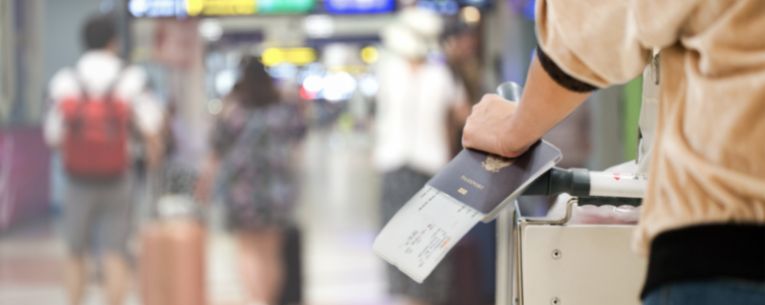You’ve waited for this trip for so long. You’ve spent so many hours in transit. And when, at last, you reach your destination, the customs official frowns. She informs you that you don’t have the right travel documents for entry. What are you supposed to do now?
Around 60,000 travelers are turned back at destination or transfer points by immigration authorities each year, according to the International Air Transport Association.1 To avoid being one of the unlucky few, use these travel document checklists to ensure you have everything you need. Keep in mind that the documents needed vary by destination.
For the latest information on travel requirements and entry restrictions for international destinations, including COVID-19 testing, vaccination policies, necessary travel documents and quarantine periods, check our interactive map. (Content is provided by Sherpa, an affiliated third party).
If I have a problem with my travel documents, can Allianz Travel Insurance help?
We’ll do our best! But the assistance we can provide depends on the situation.
If your passport or other travel documents are lost or stolen, we can assist you in getting your documents replaced, and we’re happy to help you change your travel arrangements, if needed. Your trip delay benefits can reimburse you for eligible expenses incurred (such as accommodations and meals) because of a delay caused by lost or stolen documents.
Also, if lost or stolen travel documents cause you to miss more than 50% of the length of your trip, that can be a covered reason for trip interruption, which means you can be reimbursed for your lost trip costs.
However, failing to meet a country’s entry requirements is not a covered reason for trip cancellation or interruption. If you don’t have the right documents because you didn’t know you needed them, or because you couldn’t get them in time, there’s not much we can do. Be sure to check international entry requirements before booking a trip.
What travel documents do I need for an international trip?
Valid passport: This is the most important travel document to carry. It’s required for virtually all international border crossings.
There are limited exceptions: If you have a NEXUS or SENTRI card, you can use it to enter Canada or Mexico instead of a passport. An Enhanced Driver’s License also allows you to enter the U.S. by land or sea from Canada, Mexico or the Caribbean.2 A passport card can be used to enter the U.S. by land and sea from Canada, Mexico, the Caribbean, and Bermuda.3 And U.S. citizen children under 16 who are arriving in the U.S. by land or sea from Canada or Mexico may use an original or copy of their birth certificate, a Consular Report of Birth Abroad, or a Naturalization Certificate.4
Also, you typically don’t need a passport for a closed-loop cruise — that is, a cruise that departs from and returns to the same U.S. port. You do need to provide proof of citizenship, which can be a birth certificate, a driver’s license or an Enhanced Driver’s License.5 And it’s smart to bring your passport, just in case something goes awry and you need to fly home.
Make sure you check your destination’s rules for passport expiration dates! Many countries require your passport to be valid for 3 or 6 months beyond your expected return date.6
If you’re a U.S. resident but not a citizen, you’ll need your green card (Form I-551), or document for lawful permanent residents, or advance parole (Form I-512) if your Form I-551 is pending.7
Learn more: The Ultimate Guide to Applying for a Passport & Passport Renewal
Visa: A visa is a travel document that gives you official permission to enter another country for a specified reason (e.g. tourism) and amount of time. You may need to apply ahead of time for a visa, or you may be able to get one upon entry, depending on where you’re going.
To find out if you need a visa, look up your destination country on the U.S. Department of State’s website. Be aware that you may need to provide documentation to get the visa, such as proof of sufficient funds, written evidence of a hotel reservation, or a letter stating the purpose of your trip.
Vaccination records: If your destination requires proof of COVID-19 vaccination, you should carry the original paper card. Make sure the vaccine(s) you received match the types and timeline approved by your destination. It’s a good idea to also carry digital proof of vaccination, whether photos of the card or a QR code that links to your official records.
Some countries require other vaccinations as well, such as yellow fever. Look up your destination on the CDC’s Travelers’ Health site to see which vaccinations are currently mandated or recommended. Bring your International Certificate of Vaccination to show you’ve received the required shots.
Other documents that may be needed for international travel
- A health authorization form, which some countries require because of COVID-19
- For a child who’s not accompanied by both parents, bring a notarized letter from the other parent or signed by both parents stating, “I acknowledge that my son/daughter is traveling outside the country with [the name of the adult] with my permission.”
- A valid driver’s license for driving overseas and for use as a second form of photo ID
- An International Driving Permit
- Proof of rental car insurance, such as the OneTrip Rental Car Protector
- Copies of your passport and other identification documents
- Original prescriptions for any medications, along with medication in the original packaging
- A TSA Notification Card if you have a medical condition or disability that may affect security screening. Consider obtaining a translated version for use in your destination country.
- A doctor’s letter certifying that you can travel, if (for example) you’re flying or cruising while pregnant
- Documentation for a service animal
- Proof of rabies vaccination for dogs traveling abroad. Check the requirements for other types of pets.
- Permits and/or certificates for any restricted animal or plant products
- Receipts or registration (CBP Form 4457) for new electronics, such as a camera or laptop, that you are taking abroad
- Your Global Entry or TSA PreCheck card or number. Learn more about how these programs work: The Simple Guide to Trusted Traveler Programs
- A copy of your itinerary with emergency contacts
- Printed or electronic tickets for events or attractions
- Cruise boarding documents
- Proof of travel insurance, whether printed or on the Allyz® app. Your plan documents include your policy number, which you’ll need to access 24-hour assistance.
Don’t yet have travel insurance for your trip? Don’t wait too long — buy a plan today to ensure you’re protected. Get a quote.
What travel documents do I need for a domestic trip?
Are you flying within the United States? As of May 7, 2025, U.S. travelers must have a passport, REAL ID or military ID to board domestic flights and access certain federal facilities. A REAL ID is a state-issued driver’s license/identification card with higher security standards. To get a REAL ID from your state, you’ll typically need to provide documentation showing your full legal name; date of birth; Social Security number; two proofs of address of principal residence; and lawful status. It will be marked with a star symbol to distinguish it from an ordinary license/ID card.
The TSA is testing the acceptance of certain digital IDs, including mobile driver’s licenses (mDLs) from participating states. Check this page to see if you may be able to use a digital ID to fly.
The TSA does not require children under 18 to provide identification when traveling within the United States.
Other documents that may be useful/needed for domestic travel
- A valid driver’s license
- Car insurance card
- Proof of rental car insurance, such as the OneTrip Rental Car Protector
- Health insurance card
- COVID vaccination card
- Original prescriptions for any medications, along with medication in the original packaging
- A TSA Notification Card if you have a medical condition or disability that may affect security screening.
- A doctor’s letter certifying that you can travel, if (for example) you’re flying or cruising while pregnant
- Documentation for a service animal
- Vaccination records for pets traveling with you, in case they need urgent medical care
- Your Global Entry or TSA PreCheck card or number
- Copies of your identification documents
- Membership discount/roadside assistance cards, such as AAA
- A copy of your itinerary with emergency contacts
- Printed or electronic tickets for events or attractions
- Proof of travel insurance
Related Articles








Share this Page